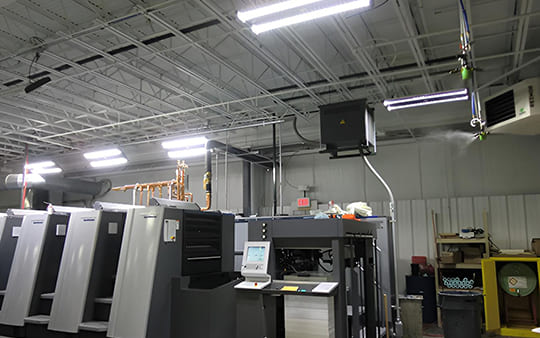
Enhance Winter Printing Efficiency with Dry Fog Humidifier AKIMist


When issues arise in the printroom, most professionals instinctively check the usual suspects: substrate inconsistencies, press settings, software errors, or operator mistakes. However, the root cause of the problem is not always on the press. Sometimes, it’s in the air.
Environmental conditions, especially relative humidity, have a direct influence on print quality, production efficiency, and equipment reliability. Despite their importance, these factors are often overlooked. If you’re grappling with persistent problems like misfeeds, poor registration, or inconsistent color, it may be time to stop adjusting your equipment and start evaluating the climate in your facility.
Humidity affects both the materials you print on and the machines you use. Paper and film absorb moisture from the surrounding air, which causes them to expand, shrink, or curl depending on the relative humidity (RH). Conversely, overly dry air can lead to static buildup that disrupts feeding, stacking, and image transfer.
Here are common print defects that often trace back to air quality:
Dry air elevates static electricity, causing sheets to cling together or resist separation in feeders. High humidity levels can have the opposite effect, making paper swell and leading to misalignment or paper jams.
Humidity-driven expansion or contraction of the substrate causes registration issues. This becomes especially noticeable in multi-pass or multi-color jobs where slight misalignments are magnified.
Ink performance is heavily influenced by RH. Shifts in humidity can affect drying times and absorption rates, leading to color shifts or blotchy finishes, particularly across different zones or print runs.
Materials like paper and film are sensitive to uneven moisture distribution. When one side absorbs more moisture than the other, curling occurs, complicating downstream processes such as cutting, folding, or binding.
Improper humidity levels disrupt the curing of coatings or the bonding of adhesive-backed materials. This is a critical concern in label and packaging production where surface performance is essential.
For most print environments, maintaining RH between 40 and 60 percent is optimal. Falling below this range results in static issues, while exceeding it compromises the dimensional stability of materials.
Several factors challenge consistent RH management. Seasonal changes, limitations in HVAC systems, and poor airflow can all contribute to unpredictable fluctuations. Even within climate-controlled facilities, different zones such as pressrooms, loading docks, storage areas, and bindery sections may behave differently and require separate attention.
Fixing climate-related print defects does not always require major press overhauls or costly upgrades. In many cases, stabilizing the indoor environment is the most efficient and affordable solution.
Dry Fog humidification technology provides a precise and effective answer. By releasing ultra-fine droplets that evaporate immediately, Dry Fog increases humidity without wetting surfaces or adding unwanted moisture to sensitive areas. These systems can be automated and zoned to maintain optimal conditions across all critical areas—from pressrooms to storage and finishing zones.
The objective isn’t to add more humidity. It’s to achieve the right humidity. Controlled, stable, and tailored to the materials and processes at hand.
If the same print defects continue to surface despite equipment adjustments, it may be time to shift focus. Evaluate the air quality. What seems like a mechanical issue could be an environmental one in disguise.
Controlling your climate gives you greater command over your print output. It reduces waste, minimizes downtime, and enhances overall efficiency.
Remember, print quality doesn’t start at the press. It starts with the air surrounding it.
